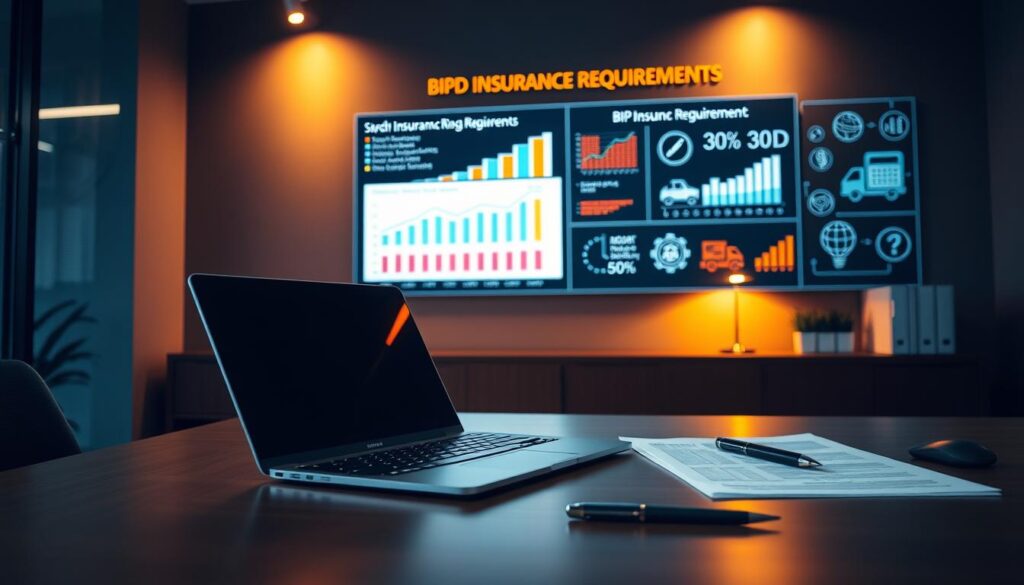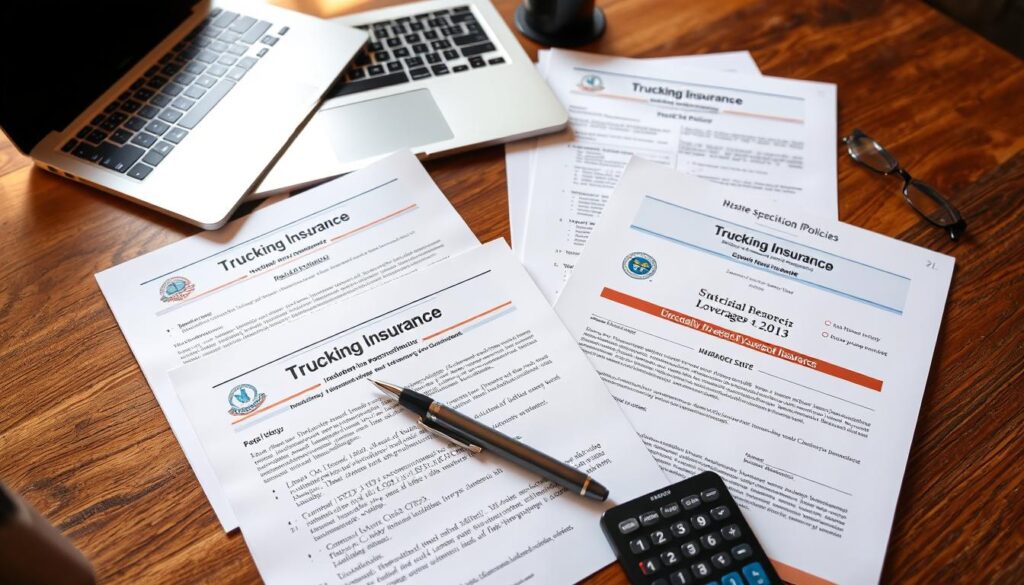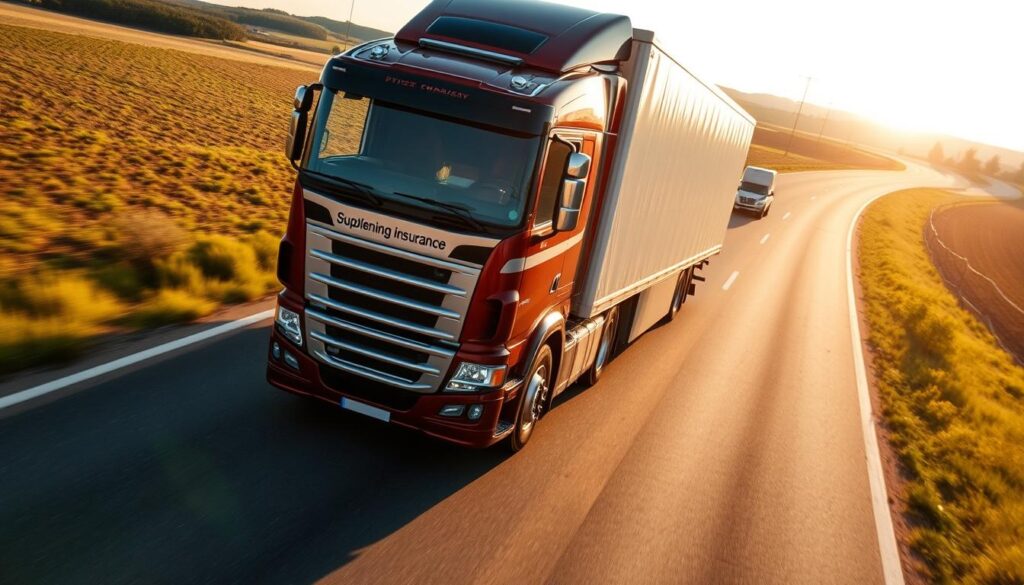As a trucking business owner, I know how vital the right liability coverage is. In the United States, commercial truck insurance is key to protect your assets and follow the rules.
BIPD insurance is a must-have for this coverage. It gives you the protection you need in case of accidents or other road incidents.
Having the right liability coverage for trucking can really help in unexpected situations.
Key Takeaways
- Understanding the importance of BIPD insurance for your trucking business.
- Knowing how commercial truck insurance protects your assets.
- Recognizing the role of liability coverage in trucking.
- Optimizing your policy to ensure compliance with regulations.
- Identifying the right coverage for your trucking business needs.
Understanding BIPD Insurance for Trucking Companies
Trucking companies face many challenges, including the need for BIPD insurance. BIPD stands for Bodily Injury and Property Damage insurance. It’s a key part of trucking insurance policies. This insurance helps cover costs from accidents, like medical bills and property damage.
Definition and Basic Components
BIPD insurance has two main parts: bodily injury coverage and property damage protection. Knowing these is key to getting the right liability coverage for trucking.
Bodily Injury Coverage Explained
Bodily injury coverage pays for medical costs, lost wages, and more when someone gets hurt in an accident with your truck. It’s important for keeping your company’s money safe.
Property Damage Protection Elements
Property damage protection covers fixing or replacing damaged property from an accident with your truck. This part of BIPD insurance is crucial for trucking liability protection.
Why It’s Essential for Trucking Operations
Getting the right BIPD insurance is vital for trucking companies. It helps manage the risks of accidents. Without enough coverage, one accident could cause big financial problems or even bankruptcy. By understanding and getting the right BIPD insurance, trucking companies can protect themselves from unexpected costs.
Breaking News: Recent Changes in BIPD Insurance Trucking Requirements
In 2023, it’s important to know about new BIPD insurance rules for trucking companies. The rules are changing, and it’s crucial to stay updated. This helps keep your business in line and covered.
2023 Regulatory Updates
2023 has seen big changes in BIPD insurance rules for trucking. One key change is the higher minimum coverage needs. Let’s look at the details in the table below:
| Regulatory Area | Previous Requirement | 2023 Update |
|---|---|---|
| Minimum Coverage | $750,000 | $1,000,000 |
| Additional Coverage Requirements | None | Mandatory for large fleets |
| Compliance Deadline | N/A | End of 2023 |
These changes aim to make the trucking industry safer and more financially stable.

How These Changes Affect Your Trucking Business
The new BIPD insurance rules will affect your trucking business. They impact compliance and costs. You need to check your insurance and update it if needed. These changes can also make your business more credible and lower your risks.
To handle these changes well, trucking businesses can:
- Check and update their insurance
- Start safety programs to lower risks
- Keep up with new rules
By doing these things, your business can stay on track and competitive in the changing trucking world.
Federal Requirements for BIPD Insurance in Trucking
The Federal Motor Carrier Safety Administration (FMCSA) has rules for BIPD insurance that trucking companies must follow. It’s key for trucking business owners to know these rules. This helps avoid penalties and ensures compliance.
Current FMCSA Regulations and Compliance Standards
The FMCSA says trucking companies need BIPD insurance that meets certain standards. The minimum coverage is $750,000 for most trucking companies. Some may need more, depending on what they carry. Companies must file the right documents and keep the coverage up to date.
Interstate vs. Intrastate Requirements
It’s important to know the difference between interstate and intrastate trucking insurance rules. Interstate trucking means moving goods across state lines. Intrastate trucking is within one state. The FMCSA oversees interstate trucking, while states handle intrastate.
Cross-Border Considerations
For companies moving across state lines, it’s crucial to understand FMCSA rules. They need the right permits and insurance. They must also follow each state’s rules.
State-to-State Operations
Intrastate trucking follows state rules, which can be different from FMCSA’s. Companies must know the rules of each state they operate in. Here’s a table showing some key differences in BIPD insurance needs:
| Operation Type | Regulatory Body | Minimum BIPD Coverage |
|---|---|---|
| Interstate | FMCSA | $750,000 |
| Intrastate | State-specific | Varies by state |
State-Specific BIPD Insurance Regulations for Truckers
BIPD insurance for trucking businesses varies by state. Each state has its own rules and minimum coverage needs. Knowing these regulations is key for truckers to follow the law and manage risks.

2023 Updates to State Minimum Coverage Requirements
In 2023, many states changed their BIPD insurance rules. For example, California now requires $15 million for bodily injury and property damage. Trucking companies must keep up with these changes to stay legal.
It’s a good idea to check your insurance policies against these new rules. You might need to change your coverage or add more insurance.
Notable State Differences Trucking Companies Should Know
States have different BIPD insurance rules. Knowing these differences helps trucking companies manage risks and follow the law.
High-Requirement States
States like New York and New Jersey have strict rules. For example, New York demands at least $1 million for bodily injury per person, $1 million per accident, and $2 million for property damage.
Lower-Requirement States
States like South Dakota have lower minimums. But, don’t just look at the minimums. Consider your cargo, fleet value, and risk level too.
By knowing the BIPD insurance rules for each state and keeping up with changes, trucking companies can control costs and risks.
What BIPD Insurance Typically Covers for Trucking Businesses
It’s important for trucking businesses to know what BIPD insurance covers. This insurance helps protect against accidents. It covers injuries and damage to property.
Bodily Injury Protection Details
Bodily injury protection is a key part of BIPD insurance. It pays for medical bills, lost wages, and more for those hurt in truck accidents.
Third-Party Injury Coverage
This coverage also helps those not in the truck. It covers people in other cars, pedestrians, and others in accidents. As the insurance world changes, having good third-party coverage is key.
Legal Defense Provisions
BIPD insurance also covers legal costs. It pays for lawyers, court fees, and more for claims and lawsuits. A recent report shows truck accident claims are getting more expensive.
“the average cost of a truck accident claim has risen significantly over the past decade”
This makes strong legal defense coverage very important.
Property Damage Coverage Specifics
Property damage coverage pays for fixing or replacing damaged things. This includes other cars, buildings, and more. The details can vary by policy and insurer.
In short, BIPD insurance is key for trucking businesses. It covers injuries and property damage. Knowing what it covers helps manage risks and meet rules.
What’s Not Covered by Standard BIPD Insurance Policies
Knowing what standard BIPD coverage doesn’t cover is key for trucking companies. BIPD insurance is vital for managing risks, but it’s not perfect. There are exclusions and limits that can surprise businesses if they’re not aware.
Common Exclusions to Be Aware Of
Standard BIPD policies often don’t cover certain incidents or damages. For example, intentional acts or criminal activities are usually not included. Also, damages from acts of war or terrorism are often excluded. It’s crucial for trucking companies to know these exclusions to manage risks well.
| Exclusion Type | Description |
|---|---|
| Intentional Acts | Damages caused intentionally by the insured or their employees. |
| Criminal Activities | Losses resulting from criminal activities, such as theft or fraud. |
| Acts of War or Terrorism | Damages caused by acts of war, terrorism, or related events. |
Supplemental Coverages to Consider
To cover gaps in standard BIPD insurance, trucking companies might need extra coverages. Two important ones are Motor Truck Cargo Insurance and Physical Damage Coverage.
Motor Truck Cargo Insurance
Motor Truck Cargo Insurance protects the goods being transported against loss or damage. It’s essential for companies that move high-value or sensitive cargo.
Physical Damage Coverage
Physical Damage Coverage guards against damage to the truck itself. This includes damage from collisions, vandalism, or natural disasters.

By knowing what standard BIPD insurance doesn’t cover and looking into extra coverages, trucking companies can protect themselves from many risks.
The Latest on BIPD Insurance Trucking Market Conditions
Looking at the BIPD insurance market, we see big changes. The trucking world faces new rules, price changes, and shifts in who offers insurance.
Current Premium Trends
BIPD insurance costs for trucking companies are going up and down for many reasons. Insurers are changing their rates to match the current risks.
- Increased claim settlements
- Rising repair costs
- Changes in FMCSA regulations
Insurance Carrier Landscape Changes
The BIPD insurance market is seeing big changes. New players are coming in with new ideas, while some are stepping back from trucking.
New Entrants to the Market
New insurance companies are joining the BIPD market. They offer better prices and new coverage options. This could make the market more competitive and help trucking businesses.
Carriers Exiting the Trucking Sector
On the other hand, some insurance companies are leaving trucking. They face too many rules and don’t make enough money. This might make the market smaller with fewer players.
Determining the Right BIPD Coverage Limits for Your Fleet
Finding the right BIPD coverage limits is key to your trucking business’s financial health. It’s important to know how to pick the right coverage for your business.
Risk Assessment Strategies
Starting with a thorough risk assessment is essential. Look at your fleet’s risks, like the cargo you carry and where you drive. This helps you spot weak spots and choose the right coverage.
- Evaluate your fleet’s safety history and driver qualifications.
- Consider the types of cargo you transport and their associated risks.
- Assess the geographic regions you operate in and their impact on risk.
Scaling Coverage with Fleet Size and Cargo Type
Your fleet’s size and cargo type are key in setting BIPD coverage limits. Bigger fleets or those with high-value or hazardous cargo need more coverage.
Small Fleet Considerations
Small fleets need to balance coverage and cost. Careful risk assessment helps pinpoint key areas to focus on.
Large Fleet Approaches
Large fleets need detailed risk management. They often get customized insurance policies that match their specific risks and safety steps.
Understanding your fleet’s unique needs and risks helps you make smart BIPD coverage choices. This way, you’re well-protected without spending too much.
Factors Affecting BIPD Insurance Premiums for Truckers
It’s important for trucking businesses to know what affects BIPD insurance costs. Many things can change how much you pay for insurance. Knowing these can help trucking companies choose the right insurance.
Driver History and Experience Considerations
A driver’s past and experience matter a lot for BIPD insurance costs. Drivers with clean records and lots of experience are seen as safer, which can lower your premiums. On the other hand, drivers with accidents or tickets are considered riskier, making insurance more expensive. Experts say, “a clean driving record can greatly lower your insurance costs, showing you’re less likely to have accidents.”
Vehicle Types and Their Impact on Rates
The vehicles in your fleet also play a part in BIPD insurance costs. Each vehicle type has its own risk level, with some being more accident-prone. For example, big trucks or those carrying dangerous goods cost more to insure because they’re riskier. Experts point out, “the type, model, and year of your trucks, plus any safety features, can change your insurance rates.”
Routes and Operational Territories
The routes and areas your trucks travel through can also affect your insurance costs. Driving in busy or crime-prone areas raises the risk of accidents or theft, which can increase your premiums. Also, going across state lines can make insurance rules more complex. As a trucking business owner, understanding these can help you find ways to lower your insurance costs.
Recent Claims Data: Why BIPD Insurance Costs Are Rising
Trucking businesses are facing higher BIPD insurance costs. This is due to more accident settlements and nuclear verdicts. The latest data shows what’s behind this trend.
Increasing Accident Settlements in 2023
In 2023, accident settlements have gone up, leading to higher BIPD insurance costs. This rise is because of higher medical costs and more complex claims.
These increased settlements are affecting the whole industry. Insurers are now charging more to cover these higher costs.
Nuclear Verdicts and Their Industry Impact
Nuclear verdicts, or jury awards over $10 million, are becoming more common in trucking. These big awards often come from well-known accidents. They greatly increase insurance costs.
Notable Recent Cases
There have been several big verdicts recently. For example, a trucking company was awarded $25 million in 2023. These large awards are adding to the cost of BIPD insurance.
Industry-Wide Implications
Nuclear verdicts affect the whole industry, not just the companies involved. Insurers raise premiums in response to these big awards. This can have a big impact on the industry.
| Year | Average Accident Settlement | Nuclear Verdicts |
|---|---|---|
| 2022 | $500,000 | 5 |
| 2023 | $750,000 | 8 |

How to Shop for the Best BIPD Insurance Trucking Policies
To protect your trucking company well, you need to know how to shop for BIPD insurance. It’s not just about looking at prices. You must also check the coverage, understand the policy details, and pick an insurance provider that fits your business.
Evaluating Insurance Providers
When looking at insurance providers for BIPD insurance, think about their reputation, financial health, and customer service. Choose insurers with a good history in trucking. They’ll likely get what you need. Also, check their ratings from trusted agencies to make sure they can pay claims.
Key factors to consider:
- Financial stability ratings
- Customer service reputation
- Experience with trucking insurance
- Claims handling process
Comparing Quotes Effectively
It’s important to compare quotes from different providers to find the best BIPD insurance policy. Make sure the coverage and deductibles are the same. Read the policy terms carefully and ask questions if you’re not sure.
Tips for effective comparison:
- Get quotes from several insurers
- Use a standard comparison template
- Look at the insurer’s reputation and price
Working with Specialized Trucking Insurance Brokers
Specialized trucking insurance brokers can be very helpful when looking for BIPD insurance. They know a lot about trucking insurance and can help you understand different policies. They also have connections with many insurance companies, so you can see more options.
Benefits of working with a broker:
- Expert knowledge of trucking insurance
- Access to many insurance providers
- Service tailored to your business needs
Cost-Saving Strategies for BIPD Insurance Without Sacrificing Coverage
In the world of trucking, it’s key to find ways to cut BIPD insurance costs. Yet, keeping good coverage is just as important. As a trucking business owner, using smart cost-saving strategies can really help your finances.
Fleet Safety Programs and Their Insurance Benefits
Fleet safety programs are vital in lowering BIPD insurance costs. They help cut down on accidents and improve driver habits. This can lead to lower premiums.
Driver Training Initiatives
Putting money into driver training initiatives can greatly lower accident risks. Good training programs teach drivers safe driving skills. This can mean fewer claims and lower insurance costs.
Safety Technology Implementation
Adding safety technology like collision avoidance systems and dash cams makes fleets safer. These tools prevent accidents and help improve driver performance.
Bundling Insurance Policies for Better Rates
Another smart move is bundling insurance policies. This means getting all your insurance needs from one provider. Often, this can lead to better rates.

Bundling policies can make managing insurance easier and save money. Always compare quotes from different providers to find the best deal.
Technology’s Role in Reducing BIPD Insurance Costs
Technology is playing a big role in cutting down BIPD insurance costs for trucking companies. The trucking world is using new tech to make driving safer, more efficient, and to manage risks better. This helps lower insurance costs.
Telematics and Driver Monitoring Systems
Telematics and driver monitoring systems are leading this tech change. They use GPS, sensors, and computers to track where trucks are, how drivers behave, and how well the trucks perform. They watch for things like speeding and harsh braking.
This helps trucking companies spot risky driving and fix it. It makes driving safer and shows they’re serious about safety. This can lead to better insurance deals.
Accident Prevention Technologies
Accident prevention tech is key to lowering BIPD insurance costs. These technologies include advanced safety features that stop accidents before they happen.
Collision Avoidance Systems
Collision avoidance systems use radar, cameras, and sensors to spot potential crashes. They alert the driver and can even apply the brakes automatically. This reduces accidents and lowers insurance claims and costs.
Smart Fleet Management Tools
Smart fleet management tools give a detailed view of a trucking fleet. They help plan routes, manage driver hours, and keep vehicles in good shape. This reduces accident risks.
These tools also collect data that shows a company’s commitment to safety. This can lead to lower insurance premiums.
By using these technologies, trucking companies can cut their BIPD insurance costs. They also get better at running their operations safely and efficiently. As tech keeps improving, its role in managing insurance costs will grow even bigger.
Case Studies: How Trucking Companies Have Optimized Their BIPD Coverage
In the trucking world, getting the most out of BIPD coverage is key to saving money. By looking at real examples, we can see how various trucking companies have tackled this issue.
This part will dive into the tactics used by small and large trucking companies to better their BIPD coverage.
Small Fleet Success Stories
Small fleets have come up with creative solutions to improve their BIPD coverage. For example, a company with 10 trucks started a strong safety program. This included training drivers and keeping vehicles in top shape. Thanks to this, they cut their BIPD insurance costs by 15%.
Another small fleet used telematics to watch driver habits. This move helped them lower their accident rates and insurance bills.
Large Carrier Strategies
Big trucking companies have also found ways to optimize their BIPD coverage. A large company with over 1,000 trucks got a special insurance deal from their provider. This deal included a self-insured retention plan. This strategy helped them keep their insurance costs under control.
Some big carriers have also put money into advanced accident prevention tech. This move greatly cut down their accident rates and insurance costs.
What to Do When Facing a BIPD Insurance Claim
After an accident, dealing with BIPD insurance claims can be tough. But, knowing the right steps can help a lot. As a trucking business owner, it’s key to handle these claims well. This way, you can avoid big financial losses and follow the rules.
Immediate Steps After an Accident
The moments right after an accident are very important. Taking the right actions early on can greatly affect your claim’s outcome.
Documentation Requirements
It’s crucial to document everything well. You should record the accident scene, get witness statements, and collect important documents like police reports and medical records. Accurate and detailed documentation is key to a strong claim.
Communication Protocols
Good communication is essential. Tell your insurance provider right away and keep a record of all talks. It’s also important to talk to everyone involved, like the police and other drivers. Clear and timely communication helps avoid confusion and speeds up the claims process.
Working with Your Insurance Provider
Working together with your insurance provider is crucial when dealing with a BIPD insurance claim. They can help you through the process, assist with paperwork, and share insights on your claim’s status.
| Best Practices | Benefits |
|---|---|
| Prompt Notification | Faster Claims Processing |
| Detailed Documentation | Stronger Claim |
| Regular Updates | Better Communication |
By following these steps and working closely with your insurance provider, you can handle the BIPD insurance claim process better.
Conclusion: Protecting Your Trucking Business with Proper BIPD Coverage
Keeping your trucking business safe is key, and the right BIPD coverage is essential. We’ve looked at what BIPD insurance is and how it works. We’ve also covered the rules at the federal and state levels.
Knowing how to get the right BIPD coverage helps protect your business. It keeps you safe from financial losses due to accidents or unexpected events. Staying up-to-date with rules, understanding your risks, and using technology can help lower costs.
Having the right trucking insurance is more than just following the law. It’s a big part of keeping your business safe. By focusing on BIPD coverage, you make sure your business can handle any challenges that come its way.
